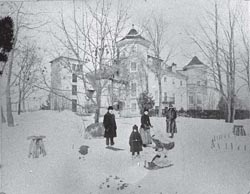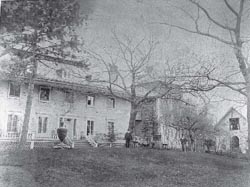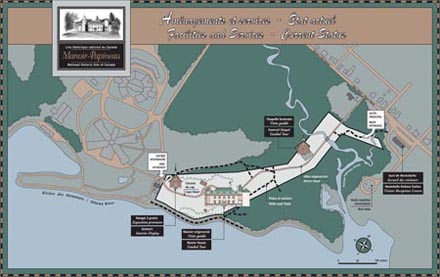2.2 State of the Site's Commemorative Integrity
As defined in the preceding section, one of the fundamental principles inherent to the concept of commemorative integrity is achieved when the resources that symbolize or characterize the national historic significance of a site are not impaired or threatened.
In the following pages, we will paint a brief picture of the current situation in terms of the cultural and landscape resources that are related to the site's commemorative intent and the conveying of messages of national historic significance.
CONDITION OF THE LANDSCAPE AND LEVEL 1 RESOURCES
Cultural landscape
The cultural landscape of the Manoir Papineau National Historic Site of Canada is based on the layout of the estate property at the time of the Papineau family, on a Picturesque style of landscaping, and on the close relationship between the landscaping elements and the site's geography.
Today, the landscape has preserved its original configuration; however, several important components are situated outside of the property transferred to Parks Canada, including the entrance gate to the estate, the gardener's cottage, the funeral chapel, the stable, the barn meadow and the riverbank. On Cape Bonsecours, nature has gradually taken over, with increasingly invasive vegetation obstructing viewpoints over the Ottawa River and the barn meadow. Furthermore, interventions by occupants of the estate after the Papineau family have altered the landscape; for example, Cape Road has been paved and the route it followed has been changed, the hedge and the road south of the manor house have been eliminated and tennis courts have been built where the barn meadow once was. While several large trees continue to provide shade over the lawns, the bountiful flower beds and vegetable gardens along the river side of Cape Road are but a memory. Overall, stripped of all its outdoor furnishings and decorative elements, the estate has lost the rustic and picturesque cachet that can be seen in old photographs.
 Winter scene in front of the manor house, circa 1886 Louis-Joseph-Amédée Papineau poses for posterity with his son Louis-Joseph, his daughter-in-law Caroline Pitkin Rogers and their children. © Parks Canada / Fonds Jacqueline Papineau-Desbaillets Reproduction: Parks Canada Neg.: 206/ic-1G/PR-6/S-109, n° 4 |
Built heritage
The state of the manor house and outbuildings at the time they were transferred to Parks Canada is the result of modifications that were made as the utilization of the buildings changed. However, these changes have not seriously compromised their integrity. Physically speaking, the state of conservation of the buildings varies: the manor house, as a result of recent conservation/restoration work, is in good condition: the granary requires some conservation work; the museum must be converted back to its original use; and the survival of the tea pavilion is uncertain. All in all, there is still considerable work to be done to completely rehabilitate the site and to achieve its commemorative integrity.
 View of the front of the manor house, the library tower and the front of the family museum, circa 1893 © Parks Canada / Fonds Renée Papineau Christie (FA-661) Reproduction: Parks Canada, neg.: 206/ic-1F/PR-6/S-64, no 2 and 3 |
The original structure of the seigneurial manor house is intact, but its outside appearance has changed as a result of various repairs. In 1979, the main roof was replaced, the siding on the octagonal towers was changed and the main part of the building, including the square tower, was covered with roughcast and painted. These repairs solved some urgent water seepage problems, but because they were carried out without sufficient historical knowledge of the residence they did not entirely respect the integrity of the building.
Before the first conservation/restoration work was begun in 1999, the seigneurial manor had the following significant technical problems:
- The stone masonry foundation had to be restored and it was imperative that a drainage system be installed around the building since water seepage had resulted in structural damage to the basement floor. The exterior window frames and trim, especially on the south side and on the corner towers, were in very poor condition. The east tower was leaning considerably due to modifications made to its structure in 1930. The latrine tower also had a tendency to lean and its roof needed to be redone. The annex built in 1880 showed serious problems with its roof, brick walls (covered with roughcast) and woodwork. Water had severely damaged the chimney stacks and the actual chimneys. The veranda, stairs and railings also showed signs of significant deterioration.
- Inside, the basement service rooms had been completely modified; the wood floor had been replaced with slate flagstones and a heating system took up part of the space originally occupied by the kitchen. The main floor had been “redecorated” with the addition of false ceilings, a new wood floor, heating cabinets under the windows and moulding; however, except for the wallpaper, which had disappeared almost entirely, the layout and decoration of the rooms had been largely preserved.
- Installation of electrical and mechanical systems in 1930 had resulted in damage to parts of the building's frame. These systems did not meet 1999 safety and comfort standards.
Work carried out since then has largely corrected these problems (See Protection and Presentation of the Site). However, on the bedroom level, untouched by the work done in 1999, the original layout was largely modified in 1930 when part of the long hallway and several bedrooms were converted into a ballroom. All the original woodwork, including the floor, have been also been replaced. The roof of the manor house has to be solidified because the frame was modified for the construction of the ballroom.
Emergency repairs were made to the granary in 1998. Conservation of the fresco-style drawings and paintings on the walls and ceiling is problematic; stabilizing work was carried out to keep their deterioration to a minimum, but a complete restoration remains to be done. The greatly deteriorated metal roofing was allowing water to leak in and had to be temporarily covered with a waterproof membrane.
The brick walls and stone foundation of the granary are generally well preserved, but repairs are still necessary. On the front of the building, the entrance steps and small balcony are in poor condition and the wooden stairway along the north gable wall has disappeared.
The family museum is in very good condition, except for the stone façade that is breaking away from the lateral brick walls. The raised roof and interior renovations have, however, altered the integrity of the building.
Of all the buildings that have survived, the tea pavilion is the most deteriorated and by far the most threatened; at this point it can be saved, but water seepage continues to damage the entire exterior wood wall on the river side; repairs must be made before the entire wall disintegrates.
Lastly, it is important to note that the frame and shingle roof of the kiosk (old campanile) are showing signs of rot.
Archaeological resources
The site's archaeological resources are generally in good condition, particularly the old landscaping elements (1850-1930) around the manor (Cape Road, Manor House Road, the road encircling the estate, the road between the manor and the granary, the path leading to the campanile, old fountains, water and drainage systems, etc.). This can be explained by the fact that the Seigniory Club, which acquired the site in 1930, did not destroy them, but covered them instead with a layer of soil on which the new landscaping elements were added.
National erosion has nonetheless considerably deteriorated the area to the west of the present tea pavilion, where a rest area had been laid out in the 1920s (the terrace around the sundial and the original trail, located at the base of the steps leading to the rest area, have completely disappeared). To the west of the rest area, traces of the gravel path leading to the garden have nonetheless resisted the ravages of time and nature fairly well. All this area, however, has been overrun with rich vegetation over the past few years, concealing the old landscaping components.
The imposing and relatively well preserved remains of the stone icehouse built north of Manor House Road, in the last curve of the road before arriving at the manor house, have been overrun with the roots of trees that have grown along the length of the walls and even inside the structure; these roots threaten to form cracks in the masonry. Lastly, it should be mentioned that the northern portion of the Papineaus' garden, located to the southwest of the manor house, was destroyed for the most part by landscaping work done by the Seigniory Club.
The archaeological collection consists of some 4,000 objects and ecofacts recovered during excavations and other Parks Canada interventions. All the preliminary processing of the materials has been done (registering, cleaning, labelling and numbering) and a summary inventory has been completed. This material remains to be analyzed.
Ethnological collection
The ethnological collection consists of 800 objects that belonged to the Papineau family. The objects have been catalogued and labelled, and the inventory has been completed. A total of 256 objects remain to be documented.
The physical condition of this collection ranges from “very good” to “satisfactory”. To preserve these items, particular care must be taken when storing and monitoring them, given the type of materials involved (veneer furniture, textiles, paintings on canvas, paper or silvered paper, metal objects, etc.). Many of these items, particularly the furniture, have been restored or will need to be in the near future, given their commemorative value.
 Manoir Papineau - Current Status For a larger version of this map click here. © Parks Canada |
COMMUNICATING MESSAGES OF THE SITE'S NATIONAL HISTORIC IMPORTANCE
After having closed the site to the public over the 2000 season because of conservation/ restoration work, Manoir Papineau re-opened its doors in the summer of 2001. To date, presentation efforts have focussed on evoking the life of the Papineau family through the decorating and furnishings of the elegant main floor. Visitors can now take a guided tour of the manor house (main floor only) that focuses on the history of the building and its occupants, and everyday family life at the time of the Papineaus.
A small thematic exhibition of the Montebello seigneury has been set up on the first floor of the granary; for safety reasons, the public still does not have access to Napoléon Bourassa's former workshop. Visitors can tour the funeral chapel accompanied by guides from the Société d'histoire Louis-Joseph-Papineau, but the tea pavilion is not open to the public. The old family museum, used primarily as an Anglican church, is accessible to the public during talks given by Parks Canada interpretive guides. On-site facilities and interpretive services are therefore still limited and incomplete14.
Furthermore, it is important to note that changes that occurred over the years in how the family museum and granary were used, combined with major changes made to landscaping elements, have meant that these resources have lost their significance as a whole and therefore do not contribute to conveying the commemorative theme as they should.
Lastly, it is important to mention that external messaging efforts have until now been achieved essentially through an internet site set up in 1999.
- To give a few examples, the commemorative theme associated with the personality of Louis-Joseph Papineau (defender of French-Canadian institutions, thinker, man of culture, seigneurial estate manager...) and messages relating to the Papineau family setting down their roots on the seigneurial estate, the administration of the seigneury etc. have barely been touched, not to say passed over in silence. Furthermore, the interpretive means currently in place cannot meet the needs of the diverse categories of visitors.
Related links
- Foreword
- index
- Introduction
- page_0_1
- 1. Commemorative Integrity of the Site
- page_1_3_1
- 1.1 Commemorative Intent
- 1.2 Resources that Symbolize or Characterize the Site's...
- 1.3 Messages of National Historic Significance (Level 1)
- 1.4 The Site's Other Heritage Values (Level 2)
- 2. Analysis of the Current Situation
- 2.3 Condition of the Environment
- 2.4 Public Visitation and Use
- 2.5 Regional Tourism and the Strategic Position of the Site
- 3. Protection and Presentation of the Site
- 3.1 Concept of Protection and Presentation
- 3.2 Directions and Management Guidelines
- 4. Summary of the Environmental Impact Assessment
- 4.2 Methodology
- 4.3 Scope
- 4.4 Appropriateness of the Strategic Goals outlined in the...
- 4.5 Identification of Sources of Impact and Assessment of...
- 4.6 Cumulative Impacts
- 4.7 Mitigation Measures
- 4.8 Conclusion
- Conclusion
- Studies and Research Reports
- page2_2_1
- courriel-email
- Date modified :